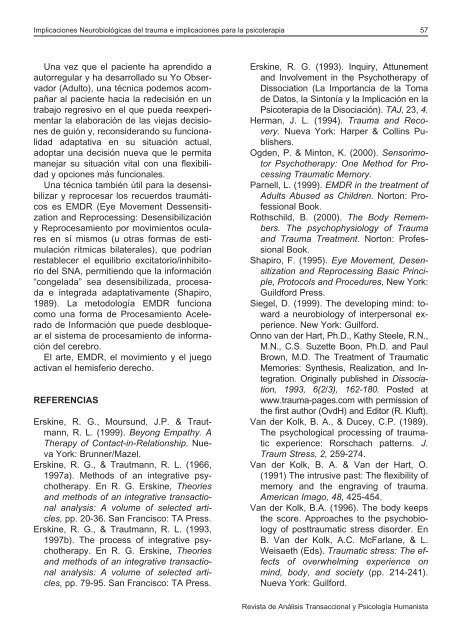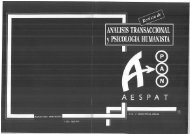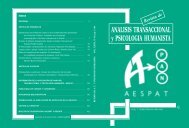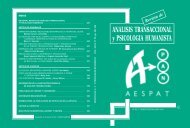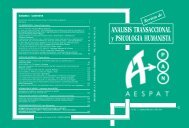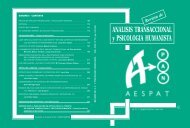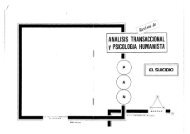Número 55 - Año XXIV - aespat
Número 55 - Año XXIV - aespat
Número 55 - Año XXIV - aespat
You also want an ePaper? Increase the reach of your titles
YUMPU automatically turns print PDFs into web optimized ePapers that Google loves.
Implicaciones Neurobiológicas del trauma e implicaciones para la psicoterapia 57<br />
Una vez que el paciente ha aprendido a<br />
autorregular y ha desarrollado su Yo Observador<br />
(Adulto), una técnica podemos acompañar<br />
al paciente hacia la redecisión en un<br />
trabajo regresivo en el que pueda reexperimentar<br />
la elaboración de las viejas decisiones<br />
de guión y, reconsiderando su funcionalidad<br />
adaptativa en su situación actual,<br />
adoptar una decisión nueva que le permita<br />
manejar su situación vital con una flexibilidad<br />
y opciones más funcionales.<br />
Una técnica también útil para la desensibilizar<br />
y reprocesar los recuerdos traumáticos<br />
es EMDR (Eye Movement Dessensitization<br />
and Reprocessing: Desensibilización<br />
y Reprocesamiento por movimientos oculares<br />
en sí mismos (u otras formas de estimulación<br />
rítmicas bilaterales), que podrían<br />
restablecer el equilibrio excitatorio/inhibitorio<br />
del SNA, permitiendo que la información<br />
“congelada” sea desensibilizada, procesada<br />
e integrada adaptativamente (Shapiro,<br />
1989). La metodología EMDR funciona<br />
como una forma de Procesamiento Acelerado<br />
de Información que puede desbloquear<br />
el sistema de procesamiento de información<br />
del cerebro.<br />
El arte, EMDR, el movimiento y el juego<br />
activan el hemisferio derecho.<br />
REFERENCIAS<br />
Erskine, R. G., Moursund, J.P. & Trautmann,<br />
R. L. (1999). Beyong Empathy. A<br />
Therapy of Contact-in-Relationship. Nueva<br />
York: Brunner/Mazel.<br />
Erskine, R. G., & Trautmann, R. L. (1966,<br />
1997a). Methods of an integrative psychotherapy.<br />
En R. G. Erskine, Theories<br />
and methods of an integrative transactional<br />
analysis: A volume of selected articles,<br />
pp. 20-36. San Francisco: TA Press.<br />
Erskine, R. G., & Trautmann, R. L. (1993,<br />
1997b). The process of integrative psychotherapy.<br />
En R. G. Erskine, Theories<br />
and methods of an integrative transactional<br />
analysis: A volume of selected articles,<br />
pp. 79-95. San Francisco: TA Press.<br />
Erskine, R. G. (1993). Inquiry, Attunement<br />
and Involvement in the Psychotherapy of<br />
Dissociation (La Importancia de la Toma<br />
de Datos, la Sintonía y la Implicación en la<br />
Psicoterapia de la Disociación). TAJ, 23, 4.<br />
Herman, J. L. (1994). Trauma and Recovery.<br />
Nueva York: Harper & Collins Publishers.<br />
Ogden, P. & Minton, K. (2000). Sensorimotor<br />
Psychotherapy: One Method for Processing<br />
Traumatic Memory.<br />
Parnell, L. (1999). EMDR in the treatment of<br />
Adults Abused as Children. Norton: Professional<br />
Book.<br />
Rothschild, B. (2000). The Body Remembers.<br />
The psychophysiology of Trauma<br />
and Trauma Treatment. Norton: Professional<br />
Book.<br />
Shapiro, F. (1995). Eye Movement, Desensitization<br />
and Reprocessing Basic Principle,<br />
Protocols and Procedures, New York:<br />
Guildford Press.<br />
Siegel, D. (1999). The developing mind: toward<br />
a neurobiology of interpersonal experience.<br />
New York: Guilford.<br />
Onno van der Hart, Ph.D., Kathy Steele, R.N.,<br />
M.N., C.S. Suzette Boon, Ph.D. and Paul<br />
Brown, M.D. The Treatment of Traumatic<br />
Memories: Synthesis, Realization, and Integration.<br />
Originally published in Dissociation,<br />
1993, 6(2/3), 162-180. Posted at<br />
www.trauma-pages.com with permission of<br />
the first author (OvdH) and Editor (R. Kluft).<br />
Van der Kolk, B. A., & Ducey, C.P. (1989).<br />
The psychological processing of traumatic<br />
experience: Rorschach patterns. J.<br />
Traum Stress, 2, 259-274.<br />
Van der Kolk, B. A. & Van der Hart, O.<br />
(1991) The intrusive past: The flexibility of<br />
memory and the engraving of trauma.<br />
American Imago, 48, 425-454.<br />
Van der Kolk, B.A. (1996). The body keeps<br />
the score. Approaches to the psychobiology<br />
of posttraumatic stress disorder. En<br />
B. Van der Kolk, A.C. McFarlane, & L.<br />
Weisaeth (Eds). Traumatic stress: The effects<br />
of overwhelming experience on<br />
mind, body, and society (pp. 214-241).<br />
Nueva York: Guilford.<br />
Revista de Análisis Transaccional y Psicología Humanista


